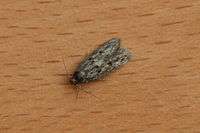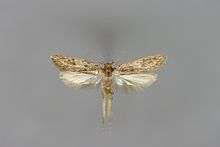Hofmannophila pseudospretella
Hofmannophila pseudospretella, the brown house moth, is a species of the concealer moth family (Oecophoridae), wherein it belongs to subfamily Oecophorinae. It is the only known member of its genus Hofmannophila, and as is often the case for such monotypic taxa, the genus' distinctness remains to be conclusively proven. However that may be, it seems to be a close relative of Borkhausenia.[1]

| Brown house moth | |
|---|---|
 | |
| Male | |
 | |
| Female | |
| Scientific classification | |
| Kingdom: | |
| Phylum: | |
| Class: | |
| Order: | |
| Family: | |
| Genus: | Hofmannophila Spuler, 1910 |
| Species: | H. pseudospretella |
| Binomial name | |
| Hofmannophila pseudospretella (Stainton, 1849) | |
Probably originally native to Asia, the synanthropic brown house moth has been introduced to other regions by human activity and is found almost worldwide today. It is often considered a pest due to the feeding activity of its caterpillars.
The wingspan is 15–26 mm. The adults fly all year round.
The caterpillars feed on organic detritus that accumulates indoors, e.g. behind skirting boards and other similar places. Recorded[2] foodstuffs are for example cereals (including maize, oatmeal, pearl barley and rice) and other seeds, potatoes, furs and dog biscuits.
Footnotes
- See references in Savela (2003)
- Grabe (1942)
References
- Grabe, Albert (1942): Eigenartige Geschmacksrichtungen bei Kleinschmetterlingsraupen ["Strange tastes among micromoth caterpillars"]. Zeitschrift des Wiener Entomologen-Vereins 27: 105-109 [in German]. PDF fulltext
- Savela, Markku (2003): Markku Savela's Lepidoptera and some other life forms – Hofmannophila. Version of 2003-DEC-29. Retrieved 2010-APR-27.